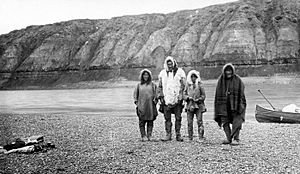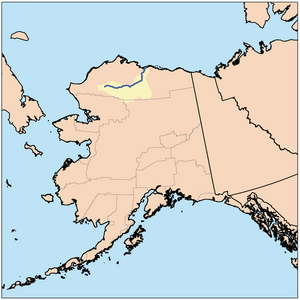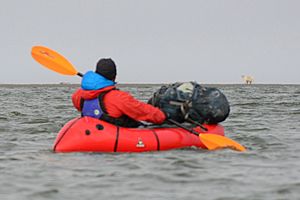Colville River (Alaska) facts for kids
Quick facts for kids Colville River |
|
|---|---|

Inupiat family on Colville River, 1901
|
|

Colville River course and drainage basin in northern Alaska.
|
|
| Country | United States |
| State | Alaska |
| Borough | North Slope |
| Physical characteristics | |
| Main source | Confluence of Thunder and Storm creeks North slope of the De Long Mountains 2,017 ft (615 m) 68°49′01″N 160°21′14″W / 68.81694°N 160.35389°W |
| River mouth | Harrison Bay, Beaufort Sea, Arctic Ocean Northeast of Nuiqsut 0 ft (0 m) 70°26′46″N 150°21′28″W / 70.44611°N 150.35778°W |
| Length | 350 mi (560 km) |
| Basin features | |
| Basin size | 20,500 sq mi (53,000 km2) |
The Colville River is a big river in Alaska, United States. It's about 350 miles (563 km) long. The local Inupiat people call it Kuukpik. It's one of the most northern big rivers in North America. It flows through a wild, flat, treeless area called tundra, north of the Brooks Range. This whole area is above the Arctic Circle. The river is frozen for over half the year and floods every spring when the ice melts.
The river starts in the De Long Mountains, which are part of the Brooks Range. It flows east through hills, getting wider as many smaller rivers join it. Part of its path forms the edge of the National Petroleum Reserve. Near the Iñupiat village of Umiat, it turns north. It then flows across the flat Arctic plain and empties into the Beaufort Sea (part of the Arctic Ocean) through a wide delta near Nuiqsut. This is about 120 miles (190 km) west of Prudhoe Bay.
The river's delta is shaped like a triangle and is about 20 by 23 by 26 miles (32 by 37 by 42 km) wide. It has 34 smaller channels that branch off and flow into the sea. The biggest channel is called the Nechalic Channel, which flows through Nuiqsut.
The Colville River valley has important deposits of petroleum (oil) and natural gas. In 2015, a bridge was built over the Colville River north of Nuiqsut. This was the first major river bridge built north of the Arctic Circle in North America. The bridge cost $100 million and helps companies like ConocoPhillips reach more oil resources.
In 1837, British explorers P. W. Dease and Thomas Simpson named the river after Andrew Colvile.
Amazing Arctic Wildlife
The Colville River and the hills around it are home to many kinds of Arctic animals. The river flows through areas where large groups of caribou live, including the Teshekpuk and Central Arctic herds. This makes the river an important landmark and sometimes a challenge during one of the world's biggest animal migrations.
You can also find brown bears here, and closer to the Arctic coast, polar bears. The Colville River is sometimes called "hawk heaven." This is because many birds of prey, like peregrine falcons, gyrfalcons, and golden eagles, gather here. The steep, crumbling riverbanks are perfect places for these birds to build their nests.
Discovering Dinosaur Fossils
In 1961, a geologist named Robert Liscolm found dinosaur fossils along the Colville River. At first, other scientists didn't believe him because it was so far north. Sadly, Liscolm died the next year.
But in the mid-1980s, Liscolm's notes were found again. Scientists went back to his sites and discovered many more dinosaur fossils and footprints! Today, the Colville River bluffs are known as one of the best places in the Arctic to find fossils. They have huge amounts of dinosaur fossils from the Cretaceous period. Some of the dinosaurs found here include theropods, ankylosaurs, albertosaurs, pachyrhinosaurus, gorgosaurus, and hadrosaurs.
Remember, fossils are any signs or remains of ancient life. If you want to collect them from public lands, you need a special permit from the government. Taking fossils illegally can lead to big fines or even jail time.
How People Use the River
In this part of Alaska, there are almost no roads. So, the Colville River acts like a highway for transportation. In the summer, small motorboats carry local hunters, scientists who study fossils, geologists, and others working or hunting in the area.
When the river freezes thick enough in winter, it can be used as an ice road. Trucks can drive on the ice to bring in supplies. This was even shown on the TV show Ice Road Truckers. A very small number of people also go boating on the Colville for fun. However, it's a very remote and tough area, with few places to get supplies and the presence of polar bears, which makes recreational boating quite challenging.
See also
 In Spanish: Río Colville para niños
In Spanish: Río Colville para niños




